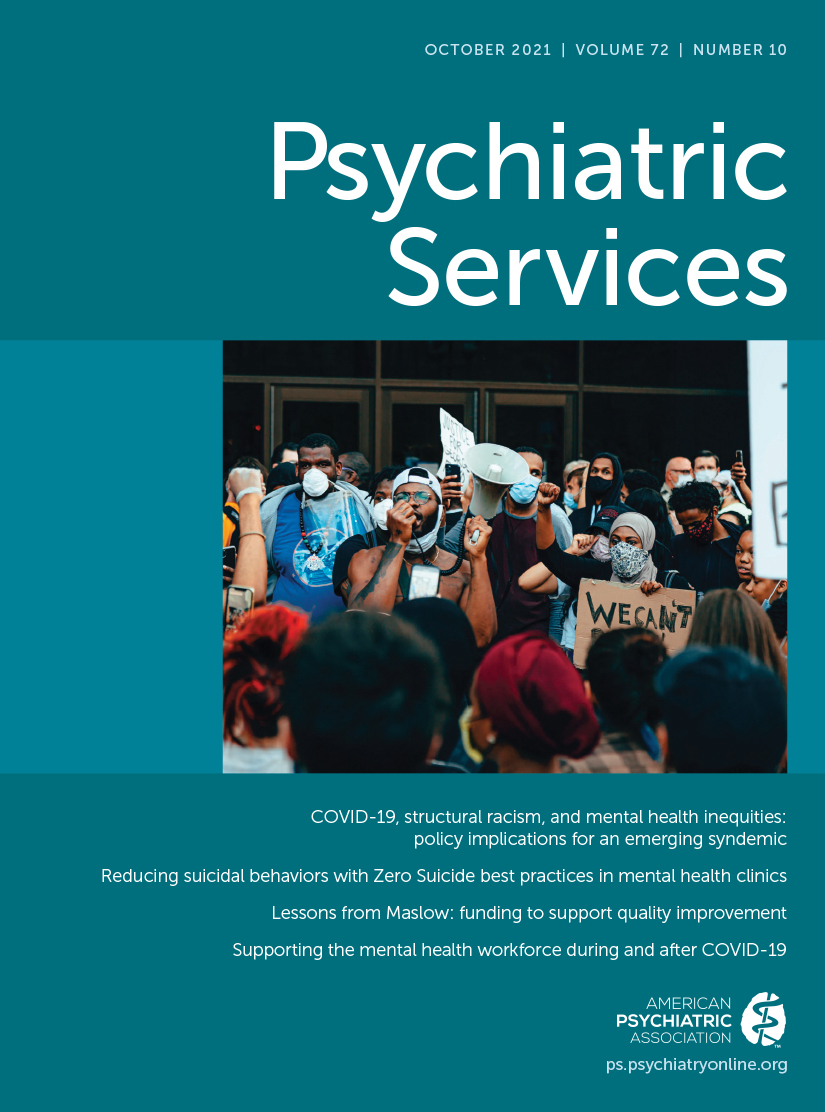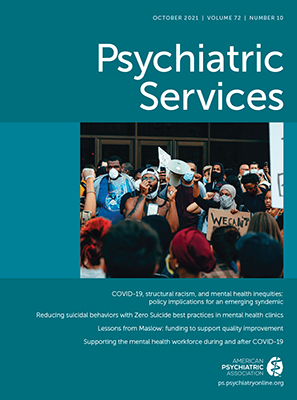Service Use by Medicaid Recipients With Serious Mental Illness During an RCT of the Bridge Peer Health Navigator Intervention
Abstract
Objective:
Methods:
Results:
Conclusions:
HIGHLIGHTS
The Bridge Intervention
Methods
Setting and Sample
Sources of Data
Measures
Service use.
Intervention contacts.
Treatment as usual.
Demographic information.
Mental health and functional outcomes.
Medical diagnoses.
Statistical Analyses
Results
Sample Baseline Characteristics
| Total sample | Waitlist control | Intervention | |||||
|---|---|---|---|---|---|---|---|
| (N=144) | (N=72) | (N=72) | |||||
| Characteristic | N | % | N | % | N | % | pa |
| Gender | |||||||
| Female | 77 | 53 | 44 | 61 | 33 | 46 | |
| Male | 67 | 47 | 28 | 39 | 39 | 54 | .09 |
| Age (M±SD) | 46.42±10.93 | 47.5±10.64 | 45.35±11.18 | .24 | |||
| Race-ethnicity | |||||||
| White | 34 | 24 | 18 | 25 | 16 | 22 | |
| Black | 11 | 8 | 5 | 7 | 6 | 8 | |
| Hispanic | 89 | 62 | 44 | 61 | 45 | 63 | |
| Other | 10 | 7 | 5 | 7 | 5 | 7 | .98 |
| Program | |||||||
| FSP/FCCSb | 106 | 74 | 50 | 69 | 56 | 78 | |
| Other | 38 | 26 | 22 | 31 | 16 | 22 | .35 |
| Diagnosis | |||||||
| Schizophrenia | 27 | 19 | 10 | 14 | 17 | 24 | |
| Schizoaffective disorder | 28 | 20 | 14 | 19 | 14 | 19 | |
| Bipolar disorder | 28 | 20 | 14 | 19 | 14 | 19 | |
| Depression | 55 | 38 | 33 | 46 | 22 | 31 | |
| Other | 6 | 4 | 2 | 3 | 4 | 6 | .28 |
| BASIS-24 score (M±SD)c | |||||||
| Depression | 2.04±1.12 | 2.11±1.14 | 1.98±1.11 | .50 | |||
| Relationships | 1.76±1.02 | 1.75±1.02 | 1.76±1.02 | .97 | |||
| Self-harm | .25±.68 | .28±.68 | .22±.69 | .63 | |||
| Emotional lability | 1.79±1.26 | 1.67±1.25 | 1.91±1.26 | .26 | |||
| Psychosis | 1.16±1.26 | 1.06±1.25 | 1.26±1.27 | .33 | |||
| Substance use | .44±.84 | .39±.75 | .49±.91 | .46 | |||
| Total | 1.62±.82 | 1.64±.83 | 1.59±.82 | .73 | |||
| Service use in 6 months prior to baseline (M±SD visits) | |||||||
| Emergency room | .59±1.16 | .69±1.31 | .49±.99 | ||||
| General medical inpatient | .03±.22 | .04±.26 | .03±.17 | ||||
| General medical outpatient | 3.19±4.53 | 2.93±3.98 | 3.44±5.04 | ||||
Intervention Character and Fidelity
Between-Group Comparisons of Service Use
| Service type | Valueb | SE | p | 95% CI |
|---|---|---|---|---|
| Emergency room | ||||
| Actual | ||||
| In 6 months prebaseline | 1.39 | .17 | .009 | 1.09 to 1.77 |
| Intervention groupc | .40 | .14 | .009 | .20 to .79 |
| Inflated | ||||
| In 6 months prebaseline | –13.40 | 7.27 | .065 | –27.64 to .84 |
| Intervention groupc | –.83 | .93 | .376 | –2.66 to 1.00 |
| General medical outpatient | ||||
| In 6 months prebaseline | 1.13 | .04 | <.001 | 1.07 to 1.21 |
| Intervention groupc | 1.05 | .24 | .850 | .66 to 1.65 |
| General medical inpatient | ||||
| In 6 months prebaseline | 2.17 | 2.07 | .418 | .34 to 14.06 |
| Intervention groupc | 1.48 | .91 | .523 | .45 to 4.95 |
Discussion
Conclusions
References
Information & Authors
Information
Published In
History
Keywords
Authors
Metrics & Citations
Metrics
Citations
Export Citations
If you have the appropriate software installed, you can download article citation data to the citation manager of your choice. Simply select your manager software from the list below and click Download.
For more information or tips please see 'Downloading to a citation manager' in the Help menu.
View Options
View options
PDF/EPUB
View PDF/EPUBLogin options
Already a subscriber? Access your subscription through your login credentials or your institution for full access to this article.
Personal login Institutional Login Open Athens loginNot a subscriber?
PsychiatryOnline subscription options offer access to the DSM-5-TR® library, books, journals, CME, and patient resources. This all-in-one virtual library provides psychiatrists and mental health professionals with key resources for diagnosis, treatment, research, and professional development.
Need more help? PsychiatryOnline Customer Service may be reached by emailing [email protected] or by calling 800-368-5777 (in the U.S.) or 703-907-7322 (outside the U.S.).

